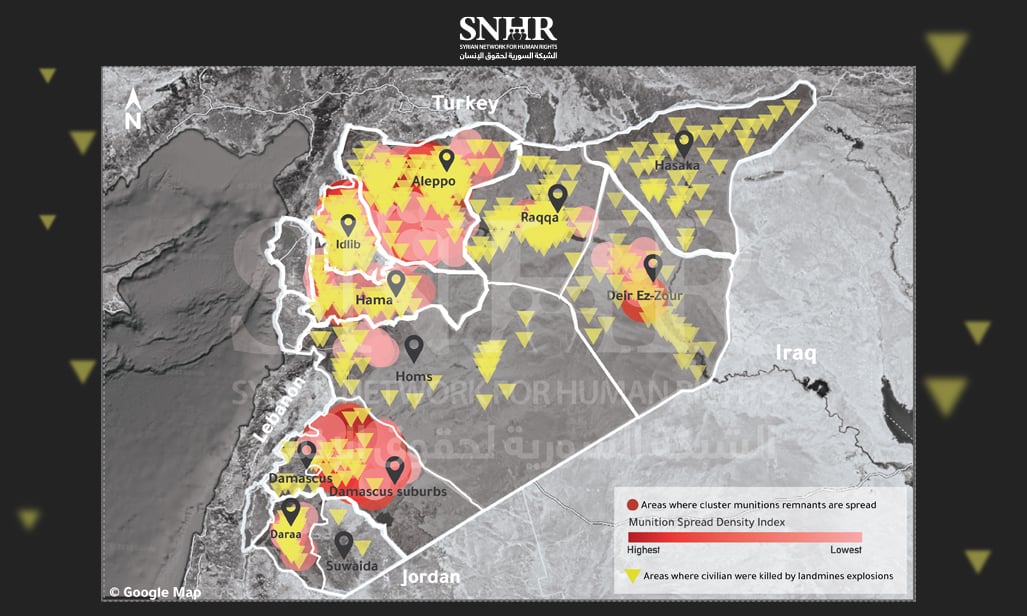A total of 3,471 civilians, including 919 children, have been documented as killed by anti-personnel landmines in Syria since 2011

Languages
Available In
Press release: (Download the full statement below)
The Hague – The Syrian Network for Human Rights (SNHR) noted in a statement released today, entitled, ‘On the International Day for Mine Awareness and Assistance in Mine Action, We Are Still Discovering New Areas Contaminated With Landmines in Syria, With More Deaths and Injuries Recorded Across the Country’, that it has documented 3,471 civilian deaths, including 919 children, as a result of landmine explosions in Syria since 2011.
The statement stresses that, for the past 13 years, SNHR has been documenting the use of APLs, including the explosions of cluster munition remnants, and the resulting casualties. While the Syrian regime had used landmines before 2011, the statement explains, the use of landmines increased exponentially and massively after the start of the popular uprising in March 2011, which subsequently turned into an internal armed conflict. Since the end of 2011, the Syrian regime has planted landmines along the borders with Lebanon and Türkiye, without placing adequate warnings. According to our monitoring, while many of the parties to the conflict and controlling forces have used APLs, only two parties have used cluster munitions whose remnants remain, namely the Syrian regime and Russian forces.
The statement includes maps showing areas contaminated with anti-personnel landmines (APLs) in Syria due to operations by parties to the conflict since March 2011. Through these maps, SNHR aims to provide a form of assistance to local teams working to remove landmines, as well as raising awareness of the dangers they continue to pose.
With large swathes of Syrian territory having been mined, we have utilized SNHR’s databases, including the one concerning the victims of landmines and cluster munitions, to create a number of maps showing the approximate locations of areas which we believe have been contaminated with APLs in many Syrian governorates. The mines and unexploded munitions in these areas will continue to pose a threat to the lives and movement of Syrian citizens, especially children, for decades to come. We designed those maps in an attempt to assist the work of local unexploded ordnance teams working to defuse the mines, and to raise awareness among local residents and authorities of the need to take the necessary precautions to avoid new incidents.
The statement documents the deaths of at least 3,471 civilians; including 919 children, 356 women, seven civil defense personnel, eight medical personnel, and nine media workers in hundreds of anti-personnel landmine explosions in Syria since March 2011 up until April 4, 2024, or International Day for Mine Awareness 2024. These are divided into 3,086 civilians; including 794 children, 325 women, seven civil defense personnel, eight medical personnel, and nine media workers; who were killed by landmine explosions, and 385 civilians, including 125 children and 31 women, who were killed by cluster munitions remnants explosions since the first documented use of these weapons in July 2012.
The statement further adds that landmines have inflicted dreadful disfigurement and serious injuries on civilians. In any landmine explosion, it’s usual for hundreds of fragments to penetrate the victim’s body, possibly resulting in amputation and the rupturing of cells, arteries and blood vessels, not to mention eye and ear injuries. Even though it is difficult to accurately determine the number of victims injured as a result of landmine explosions in Syria, we estimate that at least 10,400 civilians have been injured, with many having to undergo amputation of limbs as a result, and now being in need of artificial limbs and rehabilitation and support programs. Therefore, the continuing presence of landmines continues to pose a major obstacle to the work and return of internally displaced persons (IDPs), as well as the work of relief workers, Civil Defense personnel, and to their equipment, not to mention to the process of reconstruction and development.
The statement also stresses that the continuing deaths and injuries resulting from landmine explosions show the rampant use of this indiscriminate weapon by the various parties to the conflict in Syria. This also shows that there are still many areas which are contaminated with landmines that are yet to be discovered. Furthermore, all the parties involved in the conflict have failed to provide maps disclosing the locations of landmines, and to seriously work on removing them. Landmines are indiscriminate weapons prohibited by international law, with their sole aim being to create fear and mass terror. Landmines clearly violate the principle of distinction between civilian and military targets, as well as the principles of precautions and proportionality in attacks. The disregard for those rules constitutes a war crime according to international humanitarian law and the Rome Statute of the International Criminal Court (ICC).
The statement holds the UN Security Council primarily responsible for the state of chronic insecurity that Syria has reached due to its utter and abject failure to protect civilians in the country for the past 13 years and to bring about a political transition process until now. As long as the conflict continues, the statement notes, chaos, violations, and prohibited acts will continue to run rampant. Syria will not see stability and security without a political transition to rule by democracy, human rights and the rule of law, which in turn cannot be achieved without a strict timetable and serious and effective efforts and pressures.
The statement calls on the UN Human Rights Office (OHCHR), the UN Security Council, and the international community to greatly increase their logistical assistance to the local organizations and police working to detect and disarm landmines, to train Syrian organizations on removing landmines and unexploding cluster munitions, to raise local awareness on these types of danger, and to work on pinpointing the most prominent locations where landmines were planted, in addition to making other recommendations.


